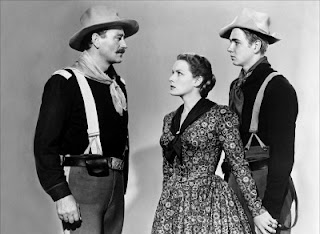 |
| John Wayne, Maureen O'Hara, Claude Jarman, Jr 1950 Rio Grande |
These tenets of an ethical lifestyle were followed by film and TV western actors in their careers as well as personal life.
Cowboy John Wayne
Although many films in the western genre were made prior to John Wayne's popularity as a film star, an examination of the fifties cowboy's philosophy of moral obligation would have to begin with The Duke.
It was the American icon John Wayne who said, "A man’s got to have a code, a creed to live by, no matter his job."
Most of the western movies depicted the late 19th century Wild West as either a forbidding wilderness or a desolate wasteland in need of a knight in shining armor to save the damsel in distress. The cowboy boot shod, white hat wearing, and pistol packing cowboy hero was the embodiment of gallantry and honor.
In both "Stagecoach" and "Angel and the Badman", John Wayne portrays a renegade with chivalrous tendencies whose love for a good woman causes him to turn from his outlaw ways.
Cowboy Jimmy Stewart
James Stewart teamed up with Director Anthony Mann for a series of fifties westerns that portrayed Stewart as a sometimes reluctant hero as well as presenting a more realistic depiction of the American West.
For those of us growing up in the 1950's, the fifties cowboys were a staple on the newly popular television sets. The TV westerns were initially re-broadcasts of B-Westerns and even some old radio shows.
 |
| Lone Ranger on Silver and Tonto on Scout |
The Lone Ranger was wildly popular during the fifties and none of us raised during that time will forget the Lone Ranger's shout, "Hi-yo, Silver! Away!" as he and his Native American friend Tonto gallop into the sunset. The Lone Ranger's strict moral code of conduct, "In order to have a friend, a man must be one" was the basis of his reference as "Ke-mo sah-bee" or "trusted friend.
Yodeling Cowboy Gene Autry
A pioneer in the popular western singer character, Gene Autry began his career in 1929 as "Oklahoma's Yodeling Cowboy" at KVOO in Tulsa, Oklahoma. By 1940 he was voted the fourth biggest box office draw at that time. In all he made 640 recordings with one of his records being the first ever to be certified gold. By 1947, Autry had mandated a code of behavior during his Melody Ranch radio programs with honesty, respect, and trust the governing aspect. These rules or "Cowboy Code" began to be publicized and are evident in every one of "The Gene Autry Show" series.
Singing Cowboy Roy Rogers
Roy Rogers was another one of the very popular singing cowboy genre on radio, film, and television during the thirties, forties, and fifties. Roy Rogers was labeled "King of the Cowboys" and along with his "Queen of the West" wife, Dale Evans, gained an iconic following championing patriotism and heroism.
Following in the footsteps of the cowboy series of early television were the longer running series whose characters also adopted the characteristic morals and ethics of the fifties cowboys. The most notable of these old westerns were Gunsmoke, Bonanza, Wagon Train, The Virginian, and Rawhide.
Perhaps present day America could learn from the fifties cowboys and we could once again have role models with standards and values.

No comments:
Post a Comment